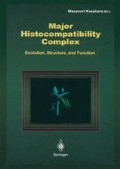Summary
The major histocompatibility complex (MHC) is a genomic region that has for many years interested immunologists, population geneticists, and evolutionary biologists (Klein 1986). Here we present a hypothesis regarding the evolution of this chromosomal region and a strategy that we have developed to test this hypothesis.
Access this chapter
Tax calculation will be finalised at checkout
Purchases are for personal use only
Preview
Unable to display preview. Download preview PDF.
References
Abi Rached L, McDermott MF, Pontarotti P (1999) The MHC big bang. Immunol Rev 167: 33–44
Aquadro CF (1992) Why is the genome variable? Insights from Drosophila. Trends Genet 8: 355–362
Ayer-LeLievre C, Henry J, Gallinaro H, Avoustin P, Ribouchon MT, Bouissou C, Pontarotti P (1999) The olfactory receptor gene cluster in the major histocompatibility complex (MHC) of man and mouse: new insights into the evolution of the vertebrate olfactory receptor gene family. in press
Doolittle RF, Feng DF, Tsang S, Cho G, Little E (1996) Determining divergence times of the major kingdoms of living organisms with a protein clock. Science 271: 470–477
Gallinaro H, Amadou C, Avoustin P, Ribouchon MT, Bouissou C, Lapointe F, Pontarotti P, Ayer-LeLièvre C (1997) Identification of new olfactory receptor genes located close to the human major histocompatibility complex. In: Charron D (ed) Genetic Diversity of HLA: Functional and Medical Implication. EDK, Vol. 2, pp 233–236
Henry J, Mather IH, McDermott MF, Pontarotti P (1998) B30.2-like domain proteins: update and new insights into a rapidly expanding family of proteins. Mol Biol Evol 15: 1696–1705
Henry J, Miller MM, Pontarotti P (1999) Structure and evolution of the extended B7 family. Immunol Today 20: 285–288
Holland PW, Garcia-Fernandez J, Williams NA, Sidow A (1994) Gene duplications and the origins of vertebrate development. Development (Suppl): 125–133
Hughes AL, Hughes MK (1993) Adaptive evolution in the rat olfactory receptor gene family. J Mol Evol 36: 249–254
Kasahara M, Nakaya J, Sana Y, Takahata N (1997) Chromosomal duplication and the emergence of the adaptive immune system. Trends Genet 13: 90–92
Kimura M (1983) The Neutral Theory of Molecular Evolution. Cambridge University Press, Cambridge, UK
Klein J (1986) Natural History of the Major Histocompatibility Complex. Wiley-Intersc ience Publication, New York-Chichester-Brisbane-Toronto-Singapore
Klein J, O’hUigin C (1993) Composite origin of major histocompatibility complex genes. Curr Opin Genet Dev 3: 923–930
Kumar S, Hedges SB (1998) A molecular timescale for vertebrate evolution. Nature 392: 917–920
Robertson HM (1998) Two large families of chemoreceptor genes in the nematodes Caenorhabditis elegans and Caenorhabditis briggsae reveal extensive gene duplication, diversification, movement, and intron loss. Genome Res 8: 449–463
Author information
Authors and Affiliations
Editor information
Editors and Affiliations
Rights and permissions
Copyright information
© 2000 Springer Japan
About this paper
Cite this paper
Rached, L.A., Pontarotti, P. (2000). The MHC « Big-Bang » : duplication and exon shuffling during chordate evolution. A hypothetico-deductive approach. In: Kasahara, M. (eds) Major Histocompatibility Complex. Springer, Tokyo. https://doi.org/10.1007/978-4-431-65868-9_3
Download citation
DOI: https://doi.org/10.1007/978-4-431-65868-9_3
Publisher Name: Springer, Tokyo
Print ISBN: 978-4-431-65870-2
Online ISBN: 978-4-431-65868-9
eBook Packages: Springer Book Archive

